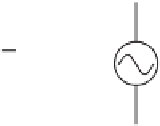Environmental Engineering Reference
In-Depth Information
+
PV
Array
Figure 4.40
PV Inverter using a high - frequency transformer
i
x
+
i
g
PV
Array
Figure 4.41
PV Inverter using a steering bridge
nection from the booster to the inverter). In this case, the control of the inverter current is
used to provide control of the DC bus voltage - if the voltage is too high, more current is
drawn, and vice versa. Maximum power point tracking is then implemented by controlling
the duty cycle of the DC booster.
A perceived drawback of this converter is that it provides no electrical isolation between
the grid and the PV array. This means that the array is at mains voltage and that for safety
requirements it must be double insulated. Some commercial inverters currently being manu-
factured are based on this arrangement.
PV Inverter Using a High Frequency Transformer
The inverter shown in Figure 4.40 has three stages. Starting from the left, the fi rst is a high
frequency inverter, which could be a quasi-square-wave inverter, or a square wave inverter.
Operation at 20 kHz is typical and this allows the transformer that follows to be much smaller,
lighter and cheaper than the mains transformer used in Figure 4.38. The transformer steps up
the voltage and provides the isolation that was missing in the circuit of Figure 4.39. Next,
the high frequency AC is rectifi ed to provide DC suitable for the fi nal stage PWM inverter
on the right of the diagram. Although this circuit appears complicated, the cost reduction of
the transformer makes it attractive to manufacturers.
PV Inverter Using a Steering Bridge
The inverter shown in Figure 4.41 again makes use of a high frequency transformer, but
differs from that of Figure 4.40 in that the power fl ow through the transformer is now modu-











































































































































































































